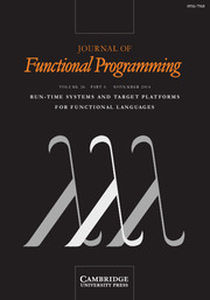VoDKA: Developing a Video-on-Demand Server using Distributed Functional Programming
Published online by Cambridge University Press: 01 June 2005
Abstract
In this paper, we present some experience of using the concurrent functional language Erlang to implement a distributed video-on-demand server. For performance reasons, the server is deployed in a cheap cluster made from off-the-shelf components. The demanding system requirements, in addition to the complex and ever-changing domain, suggested a highly flexible and scalable architecture as well as a quite sophisticated control software. Functional programming played a key role in the development, allowing us to identify functional abstractions throughout the system. Using these building blocks, large configurations can be defined using functional and process composition, reducing the effort spent on adapting the system to the frequent changes in requirements. The server evolved from a prototype that was the result of a project supported by a regional cable company, and it is currently being used to provide services for real-world users. Despite our initial concerns, efficiency has not been a major issue.
Information
- Type
- Research Article
- Information
- Copyright
- © 2005 Cambridge University Press
Footnotes
- 13
- Cited by


Discussions
No Discussions have been published for this article.